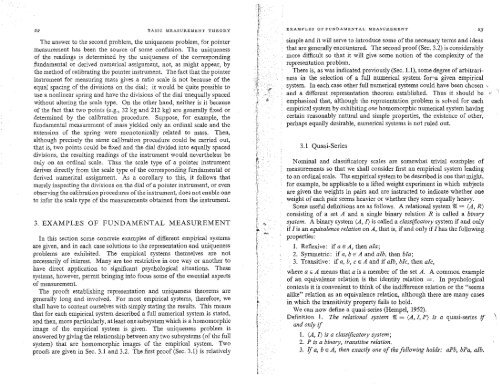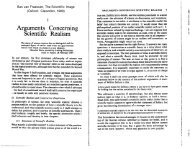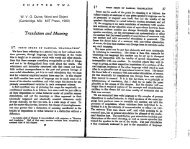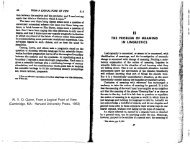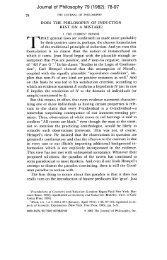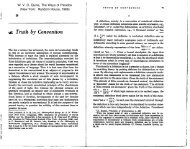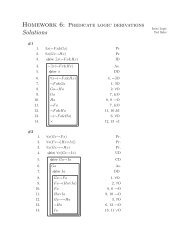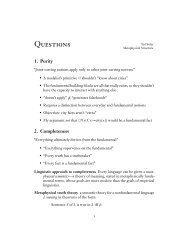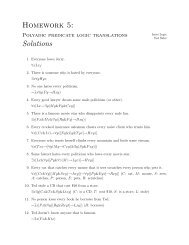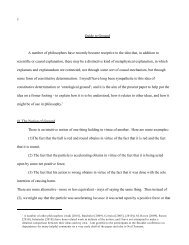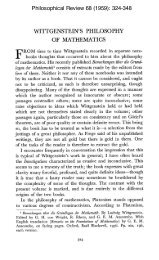Suppes and Zinnes - basic measurement theory.pdf - Ted Sider
Suppes and Zinnes - basic measurement theory.pdf - Ted Sider
Suppes and Zinnes - basic measurement theory.pdf - Ted Sider
Create successful ePaper yourself
Turn your PDF publications into a flip-book with our unique Google optimized e-Paper software.
22 BASIC MEASUREMENT THEORY<br />
The answer to the second problem, the uniqueness problem, for pointer<br />
<strong>measurement</strong> has been the source of some confusion. The uniqueness<br />
of the readings is determined by the uniqueness of the corresponding<br />
fundamental or derived numerical assignment, not, as might appear, by<br />
the method of calibrating the pointer instrwnent. The fact that the pointer<br />
instrument for measuring mass gives a ratio scale is not because of the<br />
equal spacing of the divisions on the dial; it would be quite possible to<br />
use a nonlinear spring <strong>and</strong> have the divisions of the dial unequally spaced<br />
without altering the scale type, On the other h<strong>and</strong>, neither is it because<br />
of the fact that two points (e.g., 32 kg <strong>and</strong> 212 kg) are generally fixed or<br />
determined by the caiibration procedure. Suppose, for example, the<br />
fundamental <strong>measurement</strong> of mass yielded only an ordinal scale <strong>and</strong> the<br />
extension of the spring were monotonically related to mass. Then,<br />
although precisely the same calibration procedure could be carried out,<br />
that is, two points could be fixed <strong>and</strong> the dial divided into equally spaced<br />
divisions, the resulting readings of the instrument wonld nevertheless be<br />
only on an ordinal scale. Thus the scale type of a pointer instrument<br />
derives directly from the scale type of the corresponding fundamental or<br />
derived numerical assignment. As a corollary to this, it follows that<br />
merely inspecting the divisions on the dial of a pointer instrument, or even<br />
observing the calibration pfocedures of the instrument, does not enable one<br />
to infer the scale type of the <strong>measurement</strong>s obtained from the instrument.<br />
3. EXAMPLES OF FUNDAMENTAL MEASUREMENT<br />
In this section some concrete examples of different empirical systems<br />
are given, <strong>and</strong> in each case solutions to the representation <strong>and</strong> uniqueness<br />
problems are exhibited. The empirical systems themselves are not<br />
necessarily of interest. Many are too restrictive in one way or another to<br />
have direct application to significant psychological situations. These<br />
systems, however, permit bringing into focus some of the essential aspects<br />
of <strong>measurement</strong>.<br />
The proofs establishing representation <strong>and</strong> uniqueness theorems are<br />
generally long <strong>and</strong> involved. For most empirical systems, therefore, we<br />
shall have to content ourselves with simply stating the results. This means<br />
that for each empirical system described a full numerical system is stated,<br />
<strong>and</strong> then, more particularly, at least one subsystem which is a homomorphic<br />
image of the empirical system is given. The uniqueness problem is<br />
answered by giving the relationship between any two subsystems (of the full<br />
system) that are homomorphic images of the empirical system, Two<br />
proofs are given in Sec. 3.1 <strong>and</strong> 3.2. The first proof (Sec. 3.1) is relatively<br />
. ,-Ji'<br />
EXAMPLES OF FUNDAMENTAL MEASUREMENT<br />
simple <strong>and</strong> it will serve to introduce some of the necessary terms <strong>and</strong> ideas<br />
that are generally encountered. The second proof (Sec. 3.2) is considerably<br />
more difficult so that it will give some notion of the complexity of the<br />
representation problem.<br />
There is, as was indicated previously (Sec. 1.1), some degree of arbitrariness<br />
in the selection of a full numerical system for'a given empirical<br />
system. In each case other full numerical systems could have been chosen<br />
<strong>and</strong> a different representation theorem established. Thus it should be<br />
emphasized that, although the representation problem is solved for each<br />
empirical system by exhibiting one homomorphic numerical system having<br />
certain reasonably natural <strong>and</strong> simple properties, the existence of other,<br />
perhaps equally desirable, nwnerical systems is not ruled out.<br />
3.1 Quasi-Series<br />
Nominal <strong>and</strong> classificatory scales are somewhat trivial examples of<br />
<strong>measurement</strong>s so that we shall consider first an empirical system leading<br />
to an ordinal scale. The empirical system to be described is one that might,<br />
for example, be applicable to a lifted weight experiment in which subjects<br />
are given the weights in pairs <strong>and</strong> are instructed to indicate whether one<br />
weight of each pair seems heavier or whether they seem equally heavy.<br />
Some useful definitions are as follows. A relational system 'lf = (A, R)<br />
consisting of a set A <strong>and</strong> a single binary relation R is called a binary<br />
system, A binary system (A, I) is called a classificatory system if <strong>and</strong> only<br />
if I is an equivalence relation on A, that is, if <strong>and</strong> only if I has the following<br />
properties:<br />
1. Reflexive: if a E A, then ala;<br />
2, Symmetric: if a, bE A <strong>and</strong> alb, then bla;<br />
3. Transitive: if a, b, c E A <strong>and</strong> if alb, blc, then ale,<br />
where a E A means that a is a member of the set A. A common example<br />
of an equivalence relation is the identity relation =. In psychological<br />
contexts it is convenient to think of the indifference relation or the "seems<br />
alike" relation as an equivalence relation, although there are many cases<br />
in which the transitivity property fails to hold,<br />
We can now define a quasi-series (Hempel, 1952).<br />
Definition L The relational system 'lf = (A,/, P) is a quasi-series if \<br />
<strong>and</strong> only if<br />
L (A, I) is a classificatory system;<br />
2. Pis a binary, transitive relation.<br />
3, If a, bE A, then exactly oneofthefollowingholds: aPb, bPa, alb,


